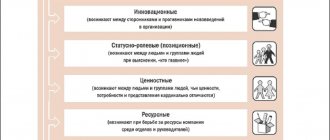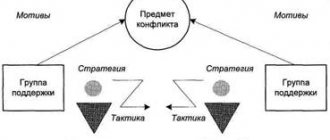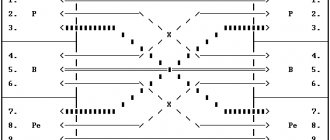Literary examples[edit]
- Sallust believed that the civil strife that led to the fall of the Roman Republic "began when the destruction of Rome's powerful enemy Carthage left it without incentive to self-discipline." [47]
- Shakespeare had Henry IV exhort his son: “Let thy business be occupied with giddy heads / With foreign quarrels.”[48]
- Swift's view of the divided Tory party at the end of Queen Anne's reign was that "a ship's crew quarreling in a storm, or while their enemies are within gunshot, is but a vague idea of the passion." [49]
Negative impacts of conflict
There are not many of them, but they are very significant:
- Destruction of friendships. If the members of two opposing groups were friends, then the further development of such relationships is a big question. Companions will try to break up the connection between their supporters and will do their best to prove that there is no need to maintain old connections.
- Any conflict interferes with the normal course of things. If there is discord between employees in a company, then the normal functioning of the enterprise will be in question. Instead of fulfilling their responsibilities, people will be busy sorting things out.
- Loss of reputation. Few people know how to control their words and take responsibility for every phrase spoken. Often people throw words into the wind without thinking about the consequences. Public statements made with zeal can backfire on any member of the group. People may say something in the heat of the moment, and they will have to spend a lot of time and effort to restore their reputation.
Prospects[edit]
Psychoanalysis[edit]
Lacan saw the roots of intragroup aggression in regression to the "narcissistic moment in the subject", emphasizing "aggression included in the effects of any regression, any arrested development, a complete abandonment of the typical development of the subject." [36] Neville Symington also saw narcissism as a key element of group conflict, highlighting "organizations so riven by narcissistic currents that ... little creativity has been done." [37] Such settings open the way to "many egoistic instinct-feelings, such as the desire to dominate and humiliate one's fellow man, the love of conflict - your courage and strength against mine - the satisfaction of being the object of jealousy, the pleasures derived from cunning, deceit and concealment." [38] Fisher (2012) distinguished between two forms of intragroup conflict in organizations. In the "reparative" form, the paranoid-schizoid "splitting" can be transformed by scapegoating the dynamic to produce reparative ("depressive") intragroup relations. in a contrasting “perverted” form, intragroup trauma causes a paranoid-schizoid functioning fragment, resulting in intersubjective “entanglement” with sadomasochistic dynamics. [39]
However, psychoanalysts themselves have not been able to escape the limitations of group conflict: "Envy, rivalry, conflicts for power, the formation of small groups leading to discord and intrigue are a given" in the psychoanalytic world, for example, with institutions "caught up in factionalism... struggle between inputs and outputs." [40]
Girard [edit]
René Girard considered "collective violence sacred... [as] the great remedy
from public life." [41] He viewed violence directed against a group scapegoat as "the absorption of all the internal tensions, hostilities and rivalries accumulated within the community... a deliberate act of collective displacement." [42]
His view parallels the Freudian approach based on Totem and Taboo
, who believes that "disturbance... lies at the root of the higher complexity to which the kingdom of civilization owes its development." [43] Freud considered violence to be the root of social bonds - "it is no longer the violence of the individual who predominates, but the violence of the community" [44] - and therefore "politics based on wrongdoing... the contract establishes corporate virtue as a refuge from individual sin." [45]
Thus, Girard concluded that regression and “the dissolution of differences promote the spread of double binds ... lead to the disintegration of social institutions” [46], in order to reveal the group conflict hidden at their core.
Conflict management
The science of conflictology resolves all issues related to controversial situations that arise in various groups. To solve any problem, you need a desire to make contact. For this purpose, each group has its own leader. A responsible person expresses the interests of his fellow humans. If all members of the group participate in resolving the conflict, a bazaar will result. Therefore, the problem will be resolved by two people or a small group of representatives of each team. Adjustment comes through discussion. The opposing sides express their opinions regarding the resolution of the conflict. As a result, the controversial situation is resolved according to one of two scenarios:
- a clear winner emerges;
- there is a compromise.
Classification of types of group conflicts
As noted above, the basic classification of types of group conflicts in the specialized literature is carried out according to their subject composition, depending on which two main types of group conflicts are distinguished:
- conflict "person - group";
- group-group conflict.
A feature of the first of these types of group conflicts is that conflict interaction in such conflicts is represented by a simultaneous clash of personal and group motives, since one of the parties presents the image of a conflict situation based on its own individual assessments and opinions, and the other through the prism of group interests and needs.
In addition, in group conflicts that develop according to the “person – group” model, great importance is attached to the question of the individual’s position in the corresponding group, i.e. characteristics of the status, role, internal attitude of the individual associated with his place in the social group, etc. The importance of this issue is determined by the fact that group conflicts arise in connection with a violation of the individual’s individual expectations of joining the corresponding social group, non-fulfillment or impossibility of fulfilling the norms and rules adopted in the group, etc.
In form, conflicts of this type can be expressed in the application of sanctions to the party represented by the individual by the group, restrictions on communication and interaction between representatives of the group and the individual opposing it, sharp criticism of him, etc.
In turn, conflicts, the parties of which are small social groups, arise in connection with the collision of multidirectional group interests, values, opinions and motives.
Functions
Conflicts are an integral part of any relationship. Therefore, it should not be surprising that they have both positive and negative functions.
- Uniting like-minded people. Collective intelligence helps you quickly achieve your goals. People bond and function well as a group. United by common interests, they can create something new, find interesting solutions to problems and quickly achieve their goals.
- Discharge tension. Any misunderstanding leads to a tense atmosphere in the group. People cannot think soberly because their nervous system is under tension. Successful conflict resolution helps a person release their emotions and feel better.
- Emotional costs. People who are in conflict with someone injure their nervous system. They cannot focus on anything other than their problems. And until the conflict is resolved, they will be in limbo.
Links[edit]
- Sigmund Freud, Civilization, Society and Religion
(PFL 12) p. 353 - Rusch, H.; Gavrilets, S. (2017). "The Logic of Animal Intergroup Conflict: A Review." Journal of Economic Behavior and Organization
. DOI: 10.1016/j.jebo.2017.05.004. - Böhm, R.; Rusch, H.; Baron, B. (2018). "The Psychology of Intergroup Conflict: A Review of Theories and Measures." Journal of Economic Behavior and Organization
. DOI: 10.1016/j.jebo.2018.01.020. - Jump up
↑ Desmond Morris,
The Naked Ape Trilogy
(1994) p. 251 - R. D. Laing, The Politics of Experience
(1984) p. 64 - Jump up
↑ Forsyth, D. R. (2009).
Group dynamics
(5th ed.). Pacific Grove, CA: Brooks/Cole. - Eliot R. Smith / Diane M. Mackie, Social Psychology
(2007) p. 515 - Smith/Mackie, p. 515
- Smith/Mackie, p. 498
- Jump up
↑ Desmond Morris,
The Naked Ape Trilogy
(1994) p. 255 - R. Skinner / J. Cleese, Families and How to Survive Them
(1993) p. 135 - Sigmund Freud, Civilization, Society and Religion
(PFL 12) p. 305 - Morris, page 254
- ^ B s d e e Eidelson, R. J., & Eidelson, S. O. (2003). "Dangerous Ideas: Five Beliefs That Drive Groups to Conflict." American psychologist
. Vol. 58. No. 3, 182–192. - Gonen, J. Y. The Roots of Nazi Psychology: Hitler's Utopian Barbarism
. Lexington: University of Kentucky Press. - Su, D. W., Bingham, R. P., Porche-Berca, L., & Vasquez, M. (1999). Diversifying psychology: A multicultural revolution. American Psychologist, 1061–1069.
- Su, D. W., Bingham, R. P., Porche-Berca, L., & Vasquez, M. (1999). "Diversifying Psychology: A Multicultural Revolution." American psychologist
. 1061–1069. - Su, D. W., Bingham, R. P., Porche-Berca, L., & Vasquez, M. (1999). Diversifying psychology: A multicultural revolution. American psychologist
. 1061–1069. - Jump up
↑ Volkan, V. D. (1999).
"Psychoanalysis and Diplomacy: Part 1. Individual and Large Group Identity." Journal of Applied Psychoanalytic Research
. pp. 29–55. - Erikson, E. H. Childhood and Society
. New York: Norton. - Kramer, R. M.; Messick, D. M. (1998). Getting along with a little help from our enemies: Collective paranoia and its role in intergroup relations. In: Intergroup cognition and intergroup behavior. K. Sedikides, J. Schopler and K. A. Insko (eds.)
. Mahwah, NJ: Lawrence Erlbaum Associates. pp. 233–255. - Gamson, W. A. (1995). Construction of a social process. In H. Johnston and B. Klandermans (eds.), Social Movements and Culture
. Minneapolis: University of Minnesota Press. pp. 85–106. - ↑
Horowitz, David, (2001). Ethnic Groups in Conflict, updated edition with new preface, 2nd edition, University of California Press, pp. 161-175 - Houle, Cyril O. (1989). Boards: Their Character and Education. San Francisco, CA: Jossey-Bass. ISBN 1-55542-157-1.
- Ilgen, D. R.; Mitchell, T. R.; Fredrickson, J. W. (1981). "Bad Performers: Feedback from Managers and Subordinates." Organizational Behavior and Human Performance
.
27
(3):386–410. - Amin Ghaziani, Dividends of Dissent
(2008) pp. 15–20 - R. Skinner / J. Cleese, Families and How to Survive Them
(1994) p. 132–3 - Engleberg, Isa N.; Wynn, Dianna R. (2007) (in English). group work 175–193 (4th ed.). Boston New York: Houghton Mifflin Company.
- Smith/Mackie, p. 448
- ↑
Randy Hodson,
Dignity at Work
(2001) p. 215 and p. 218 - ^ ab Aamodt, M. G. (2016) Industrial/Organizational Psychology: An Applied Approach.
Boston, MA: Cengage Learning, 489. - Moreland, R. L. & Levine, J. M. (1982). Socialization in small groups: Temporal changes in individual-group relations. Advances in Experimental Social Psychology, 15, 137-192.
- Bernard, Oladosu. "Organizational Conflict: Causes, Consequences, and Remedies" (PDF). semanticsholar.org
. International Journal of Academic Research in Economics and Management. - Wright, S. C., Tropp, L. R., & Mazziotta, A. (2017). Contact between groups, peace and conflict. Peace and Conflict: A Journal of Peace Psychology, 23, 207-209.
- Omisore, Bernard. "Organizational Conflict: Causes, Consequences, and Remedies" (PDF). semanticsholar.org
. International Journal of Academic Research in Economics and Management. - Jacques Lacan, Ecrits: Choice
(1997) p. 24 - Neville Symington, Narcissism: A New Theory
(1993) p. 10 - Jump up
↑ Clemens J. France, in J. Halliday/P. Fuller, editors,
The Psychology of Gambling
(1974), p. 151 - Fisher, Michael Daniel (September 28, 2012). "Organizational Turbulence, Challenges, and Trauma: Theorizing Mental Health Collapse." Organizational Studies
.
33
(9):1153–1173. DOI: 10.1177/0170840612448155. - Janet Malcolm, Psychoanalysis: The Impossible Profession
(1988) p. 106 and p. 65 - Girard, Job
(1987) b. 29 and page 150 - Girard, Violence and Sacred
(1977) b. 7 - Jacques Lacan, The Ethics of Psychoanalysis
(London, 1992) p. 6 - Freud, page 351
- Norman Brown, John O'Neill, Sociology as the Leather Trade
(1972), p. 47 - ↑
Girard,
Violence and the Sacred,
pp. 188 and pp. 127 - J. Boardman et al. The Oxford History of the Classical World
(1991) p. 460 - Ed. P. Alexandra, William Shakespeare: The Complete Works
(1962), p. 544 - G. M. Trevelyan, Peace and Protestant Continuity
(1965) p. 306
Stages
Each conflict goes through several stages of development from its inception to its successful resolution.
- A problem occurs. At the first stage, the essence of the issue is revealed, and a group of people tries to achieve their goals using adequate methods. Negotiations are conducted, the opinions of the parties are revealed, and opponents appear.
- Open conflict. If at the first stage it is not possible to reach a common opinion, then a cold or open war ensues. Groups discuss in a raised voice, get irritated and try in every possible way to achieve what they want.
- Building relationships. After resolving a conflict, it is not always possible to quickly establish relationships between members of different groups. If a specific group wins, then opponents may harbor resentment, which will become a reason for a new conflict. Therefore, when resolving any controversial issue, you need to find a compromise.
Stages of conflict resolution
To successfully resolve a controversial issue, you need to break down the problem and then eliminate it.
- Diagnostics. At this stage, groups develop their demands, choose a strategy that they will follow in order to achieve a win for the opposing side.
- Discussion. Collective bargaining between two opposing groups helps to better understand the views of the opponents. Groups put forward their demands and bring opponents up to date. After all the circumstances have been clarified, a decision can be made.
- Conflict resolution. Who is to blame and what to do is decided in the first two stages of a controversial situation. The third stage is finding a compromise or the complete victory of one of the opposing sides.
Adviсe
Do you want to quickly resolve a conflict? Then follow these tips:
- Groups that are in conflict should be forced to jointly engage in socially beneficial activities. Work brings people together. Engaging in useful activities together forces members of warring groups to look at their opponents from a different perspective. The emerging sympathy will help relieve tension and reduce it to nothing.
- If you cannot quickly resolve a controversial issue, you should replace the value system. Let what seemed like a priority fade into the background. The main thing is to make people believe that the essence of the conflict is unimportant, and it is not at all necessary to find a winner and a loser now.
- Group members must interact not only with each other, but also with other people. A person who communicates with independent people who do not take part in resolving a difficult situation can receive good advice or reconsider their views on certain things.
Causes
The sources of conflict in any group are the same. People want to achieve their goals, so they unite. What most often causes conflict?
- Social inequality. It just so happens that some people are always in a privileged position. Such people are smart, educated and wealthy. They do not want to let people with less income into their circle. This state of affairs does not suit the oppressed. They want a better life and an increase in their status.
- Misunderstanding. Each person is free to interpret events based on his own development, intelligence and morality. It is never possible to look at the same problem in the same way. Therefore, conflicts arise that divide society into several parts.
- Power struggle. No matter how good the government is, there will always be dissatisfied people. Who is to blame and what to do in such a situation, everyone decides for themselves. Most often, people are divided into groups. Some support the current order of things, while others want to change management, believing that life will be better with a change in power.
- Generation difference. People of the younger generation are liberals, and older members of society are most often conservatives. Differences in views and interests often cause conflicts.









